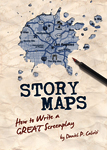Don’t suck…Suck in the Reader!
I worked for years as a professional Story Analyst, or “Reader” for major movie companies in New York City, reading and evaluating incoming screenplays and books for executives and producers who developed films like Chicago, Scream, The Game, The Faculty, Volcano, Beloved, Ulee’s Gold, and Chocolat. Their production slates ran the gamut of genres and so did the material that I was handed.
And I realized that the common wisdom about your Act One being “Setup”…is crap.
Common wisdom holds that a screenplay in its most basic structure is organized as such…
- Act One: Setup
- Act Two: Conflict
- Act Three: Resolution
I agree with the Conflict and Resolution, but I don’t like the Setup term because it just sounds so…static. And pro Readers don’t have time for static. They need a story to MOVE.
I wrote an article about what I love to see in a great Thriller and the top thing was a relentless push forward. But I will concede that this doesn’t apply only to thrillers, I think it applies to every genre.
Your first act, that crucial first 30 pages, cannot afford to lay down EXPOSITION. It must get MOVING as soon as possible — in short, it must LAUNCH LINES OF ACTION FOR A FASCINATING MAIN CHARACTER THAT SUCKS THE READER INTO THEIR WORLD AND THEIR STRUGGLE.
And this is not achieved by a character sitting in a room explaining how they had to quit college to take care of their Grandma and then they were recruited into the Army which led to them being an airborne Ranger wherein they got the world’s most elite combat training and now that Grams is imprisoned in South America by the notorious drug lord known as “El Bad-O” they must put back together the Delta Force and go rescue her.
Or something. But the point is, in those absolutely CRUCIAL first pages, you can’t afford to sit around and talk, you must SHOW us how this story is launching. And even if you don’t open on your MAIN story line, you want to get that main story line, or Story Engine as I like to call it, launched by pg. 30. Heck, page 20 is even better. (wanna go for 10?)
I say this because too many new writers take 40, 50, even 60 pages to establish the main dramatic elements of their story. To really get it going. And professionals in the industry don’t have that long to wait — they’ve got a stack of scripts on their desk they need to get through.
Going further, and to give you a little glimpse into my own method of story construction and deconstruction that I developed on the job as a Story Analyst and have taught to hundreds of writers (detailed in my E-Book Story Maps: How to Write a GREAT Screenplay), I think you should establish the main dramatic elements of your story, which I call your “Basic Story Map.” They include…
- PROTAGONIST — what makes your main character unique. Tip: try to show this through action, not just dialogue.
- EXTERNAL GOAL — the action goal for your main character (e.g., win the game, catch the killer, teach the kid).
- INTERNAL GOAL — the emotional goal for your main character (e.g., get the girl, believe in themselves, win their father’s respect).
- MAIN DRAMATIC CONFLICT or ANTAGONIST — that fascinating, powerful villain or personal problem that seems impossible for the Protagonist to defeat. Tip: this must stand directly in the way of the Protagonist achieving their goals.
- CONTROLLING THEME — that one overriding theme that the characters, conflict and actions of your story express. Examples would be “family communication” in The Sixth Sense, “the afterlife” in Gladiator or “don’t let pessimism rule you” in As Good as it Gets.
These elements may seem like obvious things to establish early on, but whether you’re just starting out with screenwriting or you’re an old pro who just banged out a first draft, it’s very difficult to see if one or more are missing. I am definitely of the camp that believes we cannot be truly objective about our own writing, so it is crucial to get other opinions.
I hope these words have inspired you to get your active story up and running so that it Sucks in the Reader!
Good luck and Happy Writing!
-Daniel Calvisi
My E-Book Story Maps: How to Write a GREAT Screenplay is available now!



Leave a Reply
Want to join the discussion?Feel free to contribute!